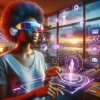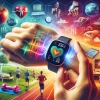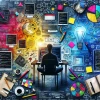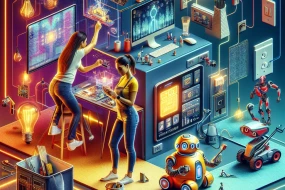
Augmented Reality (AR) is no longer a futuristic concept reserved for sci-fi movies. It's here, and it's changing the way we interact with the world. From enhancing shopping experiences to revolutionizing education, AR is being woven into the fabric of our daily lives. In this article, we'll explore practical ways you can use augmented reality every day, bringing a touch of the extraordinary to the ordinary.
Enhancing Shopping Experiences
Gone are the days when shopping meant trying on stacks of clothes in cramped fitting rooms or imagining how a piece of furniture would look in your living room. With AR, you can now try on clothes virtually or see how a sofa fits in your space—all from the comfort of your home. Applications like IKEA Place allow you to visualize furniture in your home using your smartphone, helping you make informed purchasing decisions. This technology not only saves time but also reduces the likelihood of making regrettable purchases. However, a common mistake is relying solely on AR visuals without considering factors like color accuracy and material texture, which might differ slightly from real life.
Revolutionizing Education
Education is another realm where AR is making significant strides. Imagine learning about the solar system by interacting with 3D models of planets that hover right in front of you, or studying anatomy with a virtual human body that you can explore layer by layer. Apps like Google Expeditions offer immersive learning experiences, making complex subjects more accessible and engaging. This hands-on approach not only enhances understanding but also retention of information. However, it's crucial for educators to ensure that AR is used as a supplement to traditional teaching methods, rather than a replacement.
Transforming Navigation and Travel
AR is transforming how we navigate and explore the world. Navigation apps like Google Maps have integrated AR to provide real-time directions overlaid on the real world through your smartphone camera. This feature is particularly useful in unfamiliar areas, reducing the chances of getting lost. For travel enthusiasts, AR can bring historical sites to life, offering virtual tours and detailed information about landmarks. Yet, travelers should be mindful of their surroundings and not let the digital overlay distract them from the real-world environment.
Improving Home Design and Renovation
Home design and renovation can be daunting tasks, often involving a lot of guesswork. AR applications like Houzz allow you to visualize design changes in real time. You can see how different paint colors, furniture, and decor items will look in your space before making any commitments. This not only helps in planning but also in communicating your vision to contractors and designers. However, users should be cautious about the scale and proportion of virtual items, ensuring they match the actual dimensions of their rooms.
Enhancing Social Media and Entertainment
Social media platforms are leveraging AR to create more engaging and interactive content. Snapchat and Instagram offer AR filters that transform your selfies with fun effects or immersive backgrounds. In the entertainment industry, AR has been used to create interactive gaming experiences, like Pokémon Go, which encourage physical activity and exploration. While these applications are entertaining, it's important to be aware of privacy concerns and ensure that AR features do not inadvertently share sensitive information.
Facilitating Remote Assistance
In the realm of professional services, AR is facilitating remote assistance like never before. Technicians can guide users through complex repairs by overlaying instructions on the equipment in real time. Companies like Bosch have developed AR applications to assist in automotive repairs, reducing downtime and improving service efficiency. However, it's essential to ensure that the AR guidance is clear and easy to follow, as misinterpretation could lead to further complications.
Promoting Health and Fitness
AR is also finding its way into health and fitness, offering interactive workout sessions and real-time feedback on form and technique. Applications like AR Runner gamify fitness routines, making exercise more enjoyable and motivating. While these tools can enhance your fitness journey, it's crucial to listen to your body and not over-rely on digital feedback, as improper form can lead to injuries.
Supporting Mental Health and Well-being
In the field of mental health, AR is being used to create calming environments for meditation and relaxation. Apps like Flow use AR to help users practice mindfulness and stress reduction techniques. These experiences can be personalized to suit individual preferences, providing a unique way to unwind. However, users should ensure that their AR experiences do not replace professional mental health support when needed.
Enhancing Real Estate Experiences
Real estate is another industry benefiting from AR, offering virtual tours of properties. Potential buyers can explore homes in detail without physically being there, saving time and travel costs. Companies like Zillow are incorporating AR to provide immersive property experiences. While this technology is convenient, it's important for buyers to follow up with physical visits to ensure the property meets their expectations.
Augmenting Art and Culture
AR is enriching the art and cultural sectors by providing interactive exhibits and installations. Museums are using AR to offer deeper insights into artifacts and artworks, creating a more engaging visitor experience. For instance, the Smithsonian National Museum of Natural History has integrated AR to bring exhibits to life. However, visitors should balance digital interaction with personal reflection to fully appreciate the cultural context.






























